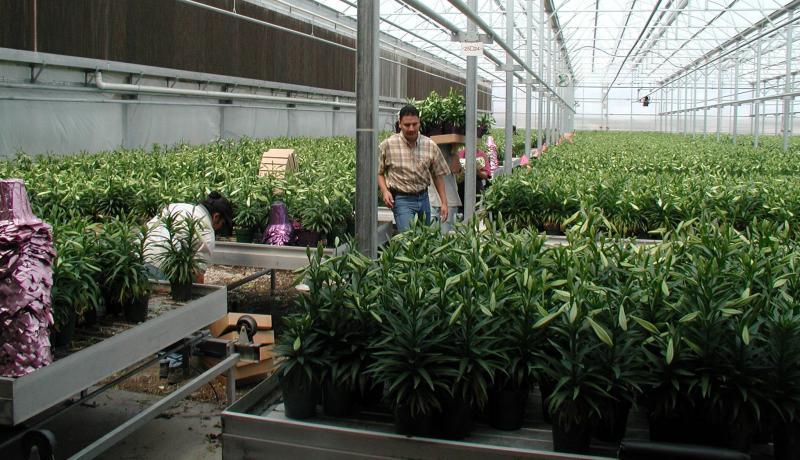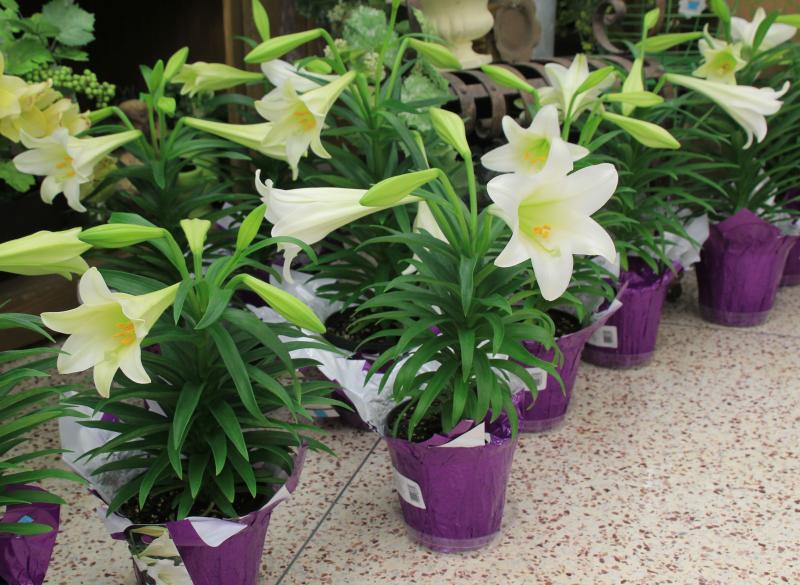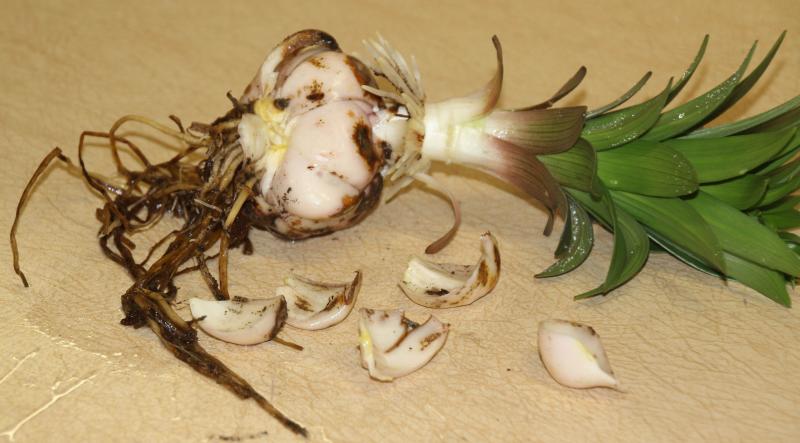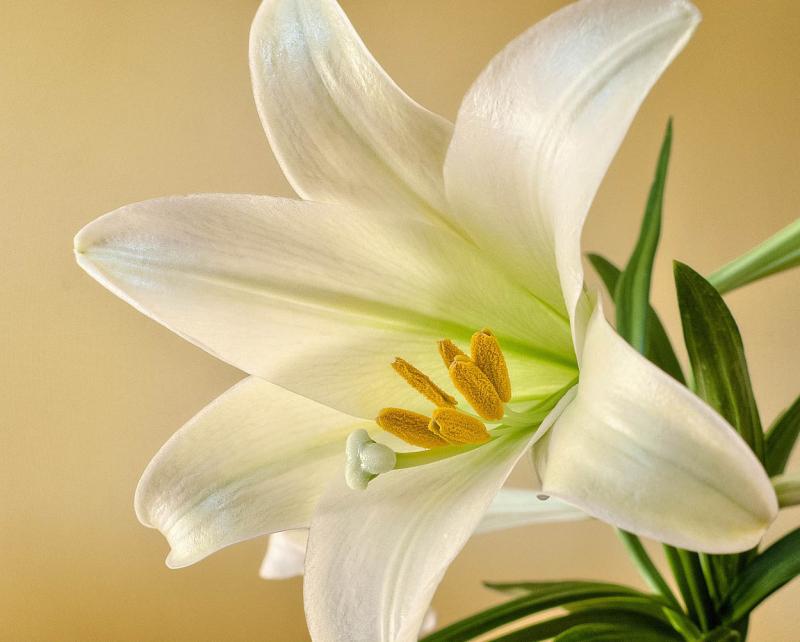Easter lily (Lilium longiflorum) plants are a sign of spring and of course Easter. They are usually only available during the week or two before Easter and usually put on closeout the week after the holiday is over. This makes growing them and in particular getting them into flower at the right time a challenge, especially since the Easter holiday is usually on a different date each spring, ranging as early as the last Sunday in March to the third Sunday in April. The actual date is determined by a formula involving the spring equinox and the date of a particular full moon. To the casual observer this would not be a problem. However, to a greenhouse grower who might produce several hundred thousand Easter lilies, this can be a real challenge.
Origin & Production

Easter lilies are native to Japan which was the primary supplier of lily bulbs to the US until World War II. Then some enterprising farmers, who had started growing their own bulbs took over. Now all of the Easter lily bulbs grown in the US are produced along the coast of California and Oregon. In fact they are produced in a very narrow stretch of farm land that has just the right growing conditions to produce the highest quality bulbs and only by a few farmers, now less than a dozen. It generally takes three to four years to produce a commercial sized bulb that is large enough to produce a nice sized plant that should have at least five flowers and might have as many as nine or ten.

Historically Easter lilies were an essential flower seen in Christian churches celebrating Easter Sunday. Often dozens of plants would be on display. However in recent years some churches have moved away from using lilies due to concerns over allergies. Typically the pollen producing structures in a flower, the five anthers, are removed from the flowers to help extend the life of the flowers and reduce the chance of staining the pure white flower petals with the golden-brown pollen. If the anthers are removed, any allergic reaction to the pollen should be greatly reduced. However some people react to the intense fragrance of the flowers. Certainly a grouping of several dozen lily plants in full bloom can perfume an entire church sanctuary. If you happen to be one of those people that do not like the fragrance or just find it too intense, that can be a problem. Now some churches are utilizing other white flowers, such as cyclamen, instead of Easter lily. The flowers have a very different appearance than the much taller lilies but they have a much lighter fragrance and generally many more flowers than an Easter lily. Some churches have even gone to using artificial lilies so that the symbolism can still be seen without some of the side effects.
Selection

There are several things to keep in mind when selecting an Easter lily plant to take home. First of all, look for good bud count. A nice sized plant should have five to seven buds or flowers. You can probably find lilies with even more flowers but you will likely pay more for those. Ideally only one or perhaps two of those buds should be open. The rest should look healthy, light green in color and at various stages of puffiness. Buds will puff up more and turn lighter green just before they are going to open. If you are going to have to transport the plant some distance or hold on to it for a few days before Easter, get one that has tighter flower buds and perhaps no flowers open. Each flower will last for a few days, depending on the temperature. Flowers will last longer in cool locations but tend to mature and wither more quickly in a warmer location. Keep the plant in a bright location to help prolong the life of the plant and flowers too.
Take a look at the height of the plant. Lilies can vary quite a bit in height. Look for one that seems to have the right proportion of height for the size of the pot. Easter lilies are usually grown in 6” pots and most people like the appearance of a plant that is 18” to 24” tall, including the pot. Also examine the leaves, especially down near the base of the stem, where it comes out of the potting soil. If there are no leaves for the first few inches of the stem, that means that the plant suffered some root loss during production from poor watering practices or from root rot. Don’t be afraid to pull back the foil or pot cover to check the leaves to see if you are getting a healthy plant.
Propogation & Care

Propagation starts in the fall when the largest bulbs are dug from the field. Lily bulbs are comprised of scales, sort of like a head of garlic, but they do not have the papery peel around each scale like garlic has. Each scale has the potential to produce several tiny bulbs. Bulbs may also develop along the stem of the plant. These are removed and replanted into the first year production field. The following fall, these are dug up and replanted in another field, then allowed to grow for another two to three years. Once the lily bulbs are large enough to harvest, they are dug, their stems are removed, and then the bulbs are cleaned, graded for size and quality then stored in moist peat moss in coolers until they are shipped out to growers around the country.

The challenge of growing Easter lilies is that it takes time for the bulbs to be chilled or vernalized in order to initiate the production of flower buds at the tip of the very short stem that is found inside the bulb. Typically bulbs are vernalized for six weeks then it takes another 110 to 115 days to get them to come into bloom. Early Easter dates means that a grower needs to have room in the greenhouse or a large cooler to provide the proper temperature and moisture conditions that lilies need in order to be properly vernalized. Often the last of the poinsettia crop is still in the greenhouse, taking up the space where the Easter lily crop needs to go. Shorter vernalization treatment times can be used but they will increase the time it takes to flower, but they increase the number of flowers that are produced. Weather conditions, particularly the amount of sunlight and even more importantly temperature speeds up or slows down how quickly lily plants grow and eventually flower. Light and temperature also affect how tall a lily plant will grow and how many flowers the plant will produce. So one of the most important aspects of growing a successful Easter lily crop is getting the timing right.
Maintenance

So, what do you do with the plants after the flowers have faded? You should know that generally Easter lily plants can survive our winters here, so you can plant them out in your garden when it warms up in the spring. If you plan to do that, move the plant into a sunny window and cut off the old flowers so that you just have the leaves left. Fertilize it every couple weeks with a water soluble houseplant fertilizer. After danger of frost is past, dig a hole slightly deeper than the original pot and plant it into the ground. Water well after planting. Next year you should see your Easter lily come up out of the ground in the spring and flower in late summer. No, it won’t come into bloom for Easter but you can still enjoy the lovely white flowers, their golden stamens and sweet fragrance. If you do not want to try to grow your lily outside, it makes a good addition to the compost pile or better yet, give it to a friend that likes to garden and would like to try growing it in their garden.


